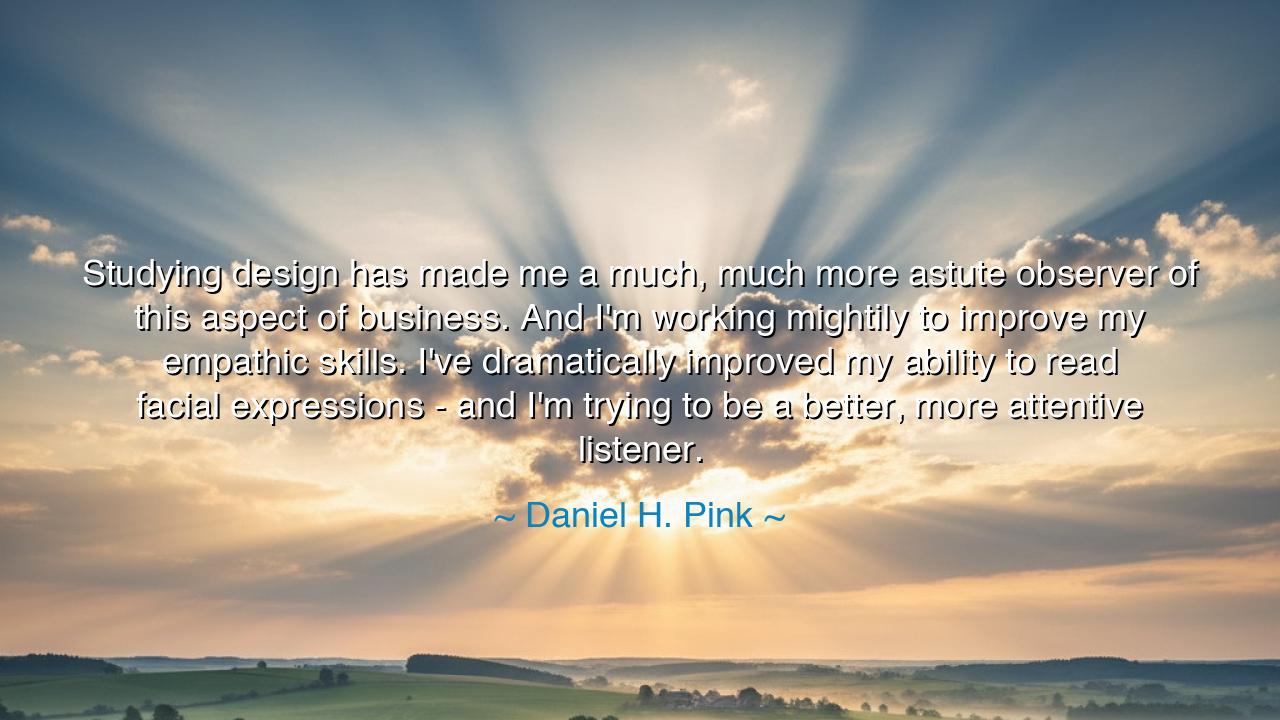
Studying design has made me a much, much more astute observer of
Studying design has made me a much, much more astute observer of this aspect of business. And I'm working mightily to improve my empathic skills. I've dramatically improved my ability to read facial expressions - and I'm trying to be a better, more attentive listener.






In the calm and reflective tone of one who has studied the world not only with the mind but with the heart, Daniel H. Pink once said: “Studying design has made me a much, much more astute observer of this aspect of business. And I'm working mightily to improve my empathic skills. I've dramatically improved my ability to read facial expressions—and I'm trying to be a better, more attentive listener.” These words, humble yet profound, are not simply about the discipline of design or the practice of business; they are about the art of seeing—the transformation of perception into wisdom. Pink, a writer and thinker on human motivation and creativity, reminds us that mastery in any field begins not with knowledge alone, but with observation, empathy, and the quiet courage to listen deeply.
To understand the origin of this quote, we must know the journey of Daniel H. Pink himself. Once a speechwriter in the halls of power, he turned away from the rigid paths of politics and bureaucracy to explore the deeper workings of human creativity, purpose, and connection. In his studies of design, he found not merely a craft of form and color, but a philosophy—a way of perceiving the world through attention and sensitivity. For design is not decoration; it is the translation of understanding into function, the shaping of the invisible emotions and needs of people into tangible reality. Through this discipline, Pink discovered that to design well, one must first see well, and to see well, one must first feel deeply.
The ancients would have understood Pink’s revelation as the cultivation of empathy—a virtue that bridges mind and soul. In the wisdom traditions of East and West alike, the greatest thinkers were those who looked and listened before they spoke. Confucius taught that a ruler must hear the cries of the people before giving orders; Socrates sought truth by questioning and listening more than by declaring. Pink’s commitment to “be a better, more attentive listener” is thus not a modern fad but an ancient discipline—the path of humility, the path of insight. He recognizes that leadership, like design, is an act of attention: to observe the subtleties of expression, to sense the unspoken emotion behind a glance or a silence, and to respond not with instinct alone, but with understanding.
When Pink speaks of improving his “ability to read facial expressions,” he touches on the forgotten art of human connection in a world drowning in distraction. To truly see another person—to perceive their joy, their discomfort, their quiet longing—is to step into their world, even for a moment. This, the ancients called sympathy of spirit. The healer must first read the pain in the eyes of the sick; the teacher must sense confusion in the posture of the student; the leader must discern unrest not in words, but in demeanor. To cultivate this power is to awaken one’s humanity, to transcend self-interest and meet others in the sacred space of awareness.
History, too, teaches us the power of this skill. Consider the story of Abraham Lincoln, a man whose leadership was rooted not in dominance but in empathy. He was known to walk among his soldiers, to look into their faces and speak with them not as a commander, but as a fellow human being. Those who met him said that he seemed to understand them before they spoke. His ability to read emotion, to listen deeply, and to reflect that understanding in his actions became one of his greatest tools of governance. Like Pink, Lincoln understood that true insight is not acquired through authority, but through attention—that to lead others, one must first learn to see them.
Pink’s reflection also unveils a profound truth about design as a way of life. To study design is to study the relationship between form and meaning, between creation and compassion. The designer asks not, “What do I want to build?” but “What do people need? What will bring them ease, joy, or clarity?” This mindset transforms business from mere transaction into service, and transforms creativity from self-expression into communion. Pink’s excitement in “becoming a more astute observer” is the awakening of a higher perception—the moment when one begins to see the patterns beneath the surface of daily life, the emotions that shape every decision, every product, every conversation.
So let this be your lesson, O seeker of wisdom: learn to see, learn to listen, and learn to feel. Whether you are an artist, a leader, a teacher, or a friend, cultivate your empathic skills as a gardener tends the soil—patiently, intentionally, and with love. Look into faces, not screens. Listen not for your chance to reply, but for the truth being spoken beneath the words. As Daniel H. Pink teaches, every act of creation—whether a design, a negotiation, or a simple act of kindness—begins with attention. For when you observe with empathy, the world unfolds before you like a living map, rich with meaning and connection. And in that act of seeing, you do not merely understand others—you become more deeply, luminously human.






AAdministratorAdministrator
Welcome, honored guests. Please leave a comment, we will respond soon